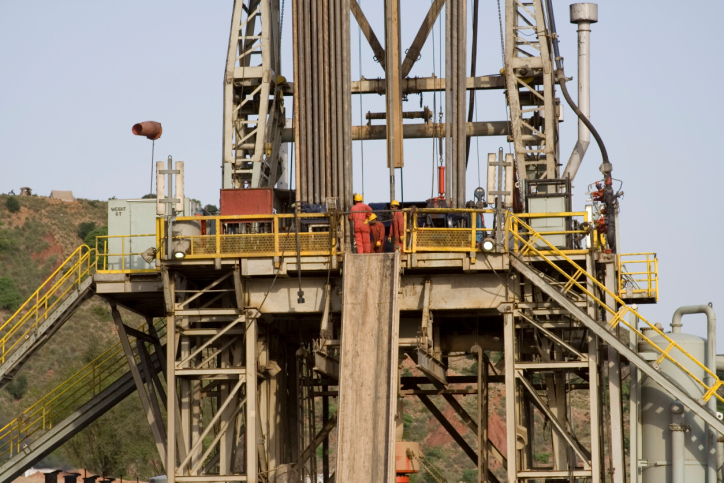Energy
Apache Takes $5.2 Billion in Charges, Slashes Rig Counts
Published:
Last Updated:

For the full year, Apache posted adjusted EPS of $5.94 on revenues of $13.85 billion, compared with EPS of $7.89 on revenues of $15.56 billion in 2013. Analysts were looking for EPS of $5.64 on revenue of $13.98 billion.
On a GAAP basis, Apache posted a quarterly EPS loss of $12.78 and a full-year loss of $14.06. The big hit came on non-cash property write-downs and impairments that cost the company $5.26 and $5.46 per share, respectively. Total non-cash charges for the quarter came to $5.2 billion.
Looking ahead, Apache estimates 2015 capital spending of $2.1 billion to $2.3 billion onshore in North America, while operating an average of 17 rigs during the year. Production is forecast to be approximately flat with the 302,000 barrels of oil equivalent per day posted in 2014, adjusted for asset sales. Internationally and offshore, Apache expects a capex spending of $1.5 billion to $1.7 billion and production is forecast to rise “slightly” from 207,000 barrels a day in 2014, again adjusted for 2014 sales and including projected asset sales in 2015.
ALSO READ: Analyst More Bullish on 5 Top Energy Stocks After Big Oil Rebound
Apache operated an average of 42 rigs in the Permian Basin in 2014 and plans to operate an average of 10 to 12 rigs in the region during 2015. In its Central Region, the company operated an average of 20 rigs in 2014 and plans to operate an average of two or three in 2015. Having sold its south Louisiana assets in 2014, the company’s Gulf Coast region is now almost all defined as its Eagle Ford properties, where Apache plans to operate one or two rigs in 2015.
The company’s 2014 non-cash write-downs included $2 billion in the carrying value of its oil and gas properties due largely to the low price of crude; $1.3 billion in goodwill impairment as a result of prior year acquisitions; $1 billion in a deferred tax adjustment; and $750 million in impairment charges for downstream LNG assets held for sale.
The company’s CEO said:
We have reduced our rig count from an average of 91 rigs in the third quarter of 2014 to an estimated 27 rigs by the end of this month. We have also reduced our frac crews by approximately 50 percent during the same time period and are delaying some well completions until service costs decrease materially. In 2015, Apache will run a streamlined capital program that focuses on efficiency improvements, downspacing and other strategic tests to further delineate our extensive inventory of locations within the Permian, Eagle Ford, Canyon Lime, Duvernay and Montney. While we are fortunate to have a substantial inventory of projects that can make economics at these oil prices, we believe it more prudent to curtail our activity until costs are lower and prices recover. This strategy will enable us to further strengthen our balance sheet and preserve the financial flexibility to capitalize on industry opportunities during the downturn.
How bad was 2014? Apache’s average price for a barrel of North American oil fell from $91.64 in the fourth quarter of 2013 to $68.21 in the fourth quarter last year. Natural gas prices rose from $3.55 per thousand cubic feet to $3.79. Internationally (Egypt and the North Sea) the average per barrel price of crude fell from $101.12 to $70.89. International natural gas prices rose from $3.78 a year ago to $3.89. It is no wonder that spending is going to be curtailed until crude prices rise.
ALSO READ: Short Sellers Press Their Bets on Major Oil
Apache’s shares traded up about 2.3% in Thursday’s early trading to $66.25, in the stock’s 52-week range of $54.34 to $104.57. The consensus target price for the shares was around $70.80 before the report.
Are you ahead, or behind on retirement? For families with more than $500,000 saved for retirement, finding a financial advisor who puts your interest first can be the difference, and today it’s easier than ever. SmartAsset’s free tool matches you with up to three fiduciary financial advisors who serve your area in minutes. Each advisor has been carefully vetted and must act in your best interests. Start your search now.
If you’ve saved and built a substantial nest egg for you and your family, don’t delay; get started right here and help your retirement dreams become a retirement reality.
Thank you for reading! Have some feedback for us?
Contact the 24/7 Wall St. editorial team.